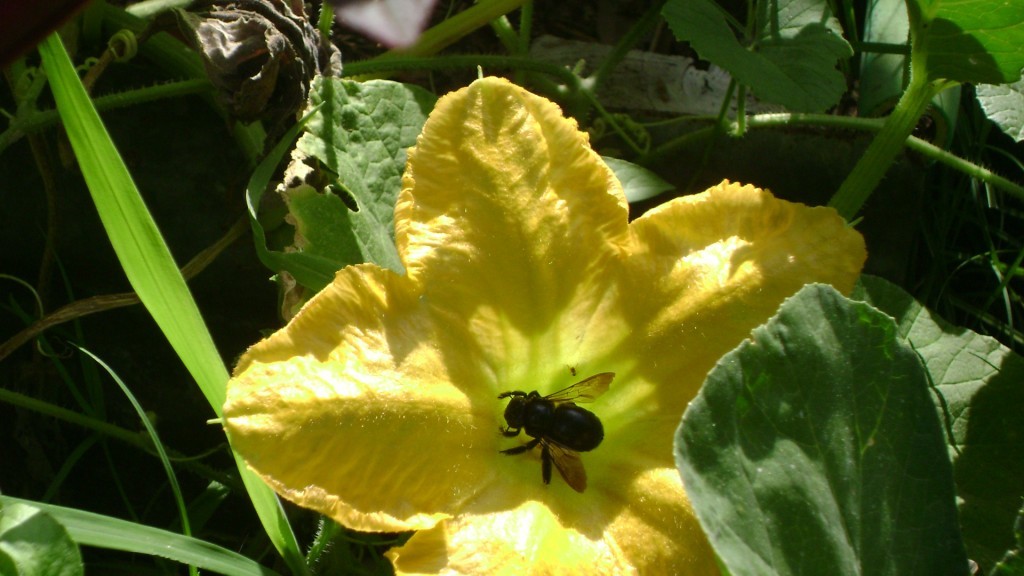The first thing every gardener needs to be aware of is that if pesticides are being used in any form or fashion the pollinators are killed too. Bumblebee is a very rare sight for many gardeners this year across the country. This photo was taken last year of a Carpenter Bee pollinating the squash in our garden. I’ve not seen a one in our garden this season.
Many plants such as squash, pumpkins, and melons really rely on the large size of bumblebees to effectively pollinate the blossoms. Without them and in most cases a gardener will end up with less production as well as deformed or shriveled up produce. It can all be quite discouraging after so much hard work has gone into the garden to get to this point. Many times gardeners don’t realize the absence of bees. Their first instinct might be to think their plants have a virus, fungus or disease when they see the deformed fruits and vegetables. Their first action might be to begin treating their plants with a herbicide.
The correct action would be to begin a hand pollinating routine. This must take place in the morning when the blooms are completely opened up. But the first thing to learn is how to tell the difference between a female flower and a male flower.
The female flower has the ovary just like us humans do. But the distinction is that directly under the bloom you will see a tiny fruit at the base. The male bloom has the pollen and sits upon the narrow stem.
When the plants first begin making blooms, usually the first week or so you will only find male flowers. So don’t panic if you don’t see a female bloom at first. Once the females appear, wait a few days to find the blossoms begin to get very mature. This will be the optimum time for hand pollination.
How To Hand Pollinate
The easiest way I’ve found to do this is to first pluck a male flower. Touch the inside stamen with your finger or a Q-tip to see if any of the yellow pollen comes off. Next, take the flower petals off of the male flower and begin to rub it around inside the female bloom. You need to stimulate the movement of the male stamen to the stigma of the female bloom in such a way as the bumblebee would do naturally. It is pure sex among the flowers and a beautiful thing.
Successfully Pollinated Squash
When successful pollination occurs by the bumblebee or by the touch of your hand you can expect to see healthy productive plants. For more information on hand pollination as well as many wonderful demonstrations and photographs visit “A Gardeners Illustrated Guide” by David L. Green.
While there is much to learn in nature, we would by far enjoy the beautiful fuzzy buzzing of our wonderful and extraordinary bees that have now begun dying at alarming rates. By sharing the importance of our precious pollinators with our neighbors and friends and encouraging them to garden naturally without the use of harmful pesticides we may still have a future that includes the Bee.
- Wild Dagga Motherwort Medicinal Herb - November 11, 2013
- Grow The Best Organic Lettuce - November 4, 2013
- Amish Hot Pepper Mustard - October 23, 2013



Bumblebees have been the primary pollinator in my garden this season. I’m so thankful as I’ve only seen two honeybees. Thanks for the great articles!
You’re very welcome! We are finally beginning to see some bumblebees coming back into the gardens here. Not much of any honeybees though. We just have to keep trying to do the right thing. 😉